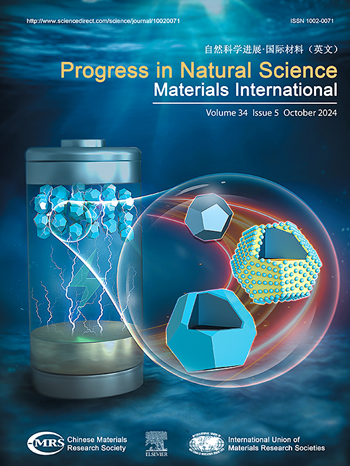Li-Cu alloy with A preferred single crystal orientation (110) plane for inhibiting dendrite growth in anode-free lithium metal batteries
IF 7.1
2区 材料科学
Q2 MATERIALS SCIENCE, MULTIDISCIPLINARY
Progress in Natural Science: Materials International
Pub Date : 2025-06-01
DOI:10.1016/j.pnsc.2025.03.011
引用次数: 0
Abstract
A formidable challenge to enhance the cycle performance of Anode-Free Lithium Metal Batteries (AFLMBs) is to suppress the uncontrollable growth of Li dendrites. Preferred orientation is an effective solution to induce Li+ uniform deposition, however, there is a dearth of adjustment methods in anode-free lithium metal batteries. Herein, a lithium-copper (LiCux) alloy current collector was obtained, in which the lithium metal deposition on the current collector was aligned with the (110) single crystal plane, thereby facilitating the formation of dendrite free lithium deposits. The experimental results show that low-temperature alloying followed by an annealing treatment enables stable alloying of Li and Cu and induces the formation of (110) crystal plane. Consequently, the LiCux-250 alloy exhibits a stable lithium deposition/stripping more than 1100 h with a high Coulombic efficiency (98.42 %). Furthermore, the cycling performance of the LiFePO4 full cell is markedly enhanced in comparison to that of bare copper. This work provides an important reference for solving the problem of lithium dendrites in anode-free lithium metal batteries.

具有优选单晶取向(110)平面的Li-Cu合金,用于抑制无阳极锂金属电池中的枝晶生长
提高无阳极锂金属电池(aflmb)循环性能的一个巨大挑战是抑制锂枝晶的不可控生长。优选取向是诱导Li+均匀沉积的有效解决方案,但在无阳极锂金属电池中缺乏调节方法。本文制备了一种锂铜(LiCux)合金集流器,其中集流器上的金属锂沉积与(110)单晶平面对齐,从而有利于无枝晶锂沉积的形成。实验结果表明,低温合金化后再进行退火处理可以使Li和Cu稳定合金化,并诱导(110)晶面的形成。结果表明,LiCux-250合金在1100 h以上表现出稳定的锂沉积/溶出,库仑效率高达98.42%。此外,与裸铜电池相比,LiFePO4电池的循环性能得到了显著提高。该工作为解决无阳极锂金属电池中锂枝晶问题提供了重要参考。
本文章由计算机程序翻译,如有差异,请以英文原文为准。
求助全文
约1分钟内获得全文
求助全文
来源期刊
CiteScore
8.60
自引率
2.10%
发文量
2812
审稿时长
49 days
期刊介绍:
Progress in Natural Science: Materials International provides scientists and engineers throughout the world with a central vehicle for the exchange and dissemination of basic theoretical studies and applied research of advanced materials. The emphasis is placed on original research, both analytical and experimental, which is of permanent interest to engineers and scientists, covering all aspects of new materials and technologies, such as, energy and environmental materials; advanced structural materials; advanced transportation materials, functional and electronic materials; nano-scale and amorphous materials; health and biological materials; materials modeling and simulation; materials characterization; and so on. The latest research achievements and innovative papers in basic theoretical studies and applied research of material science will be carefully selected and promptly reported. Thus, the aim of this Journal is to serve the global materials science and technology community with the latest research findings.
As a service to readers, an international bibliography of recent publications in advanced materials is published bimonthly.

 求助内容:
求助内容: 应助结果提醒方式:
应助结果提醒方式:


